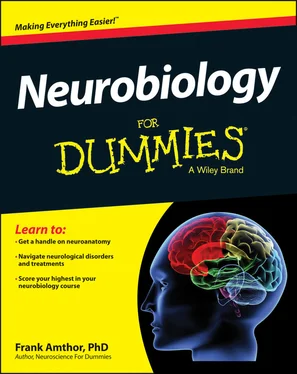1 ...6 7 8 10 11 12 ...23
Developing the brain and nervous system
The set of genes that define an organism is not a blueprint that is executed by a builder, but a set of procedures that brings about the development of the organism.
 A useful metaphor is an ant hill or termite mound. No master ant or termite knows how to build a hill or mound and directs the other insects. Instead, ants and termites respond to each other, and to the environment, by digging holes and gluing arches together. Some holes and arches reach a critical mass that causes nearby insects to concentrate on those structures and related structures, which triggers the completion of the insect home as though its builders were following a design.
A useful metaphor is an ant hill or termite mound. No master ant or termite knows how to build a hill or mound and directs the other insects. Instead, ants and termites respond to each other, and to the environment, by digging holes and gluing arches together. Some holes and arches reach a critical mass that causes nearby insects to concentrate on those structures and related structures, which triggers the completion of the insect home as though its builders were following a design.
Developing cells have genetically coded responses to substances they detect by their membranes or ingest, including cell identity and brain location marker molecules. Cell responses include movement, division, and secretion of other markers and agents. The interactions among cells that have these responses in the embryological environment builds the brain.
Much of the genome is only expressed extensively during development, a time when the organism is also particularly susceptible to toxins that mimic or interfere with these markers and agents. The result of this interference is the construction of an improperly set-up brain, which is typically much worse than inferring temporarily with a properly constructed brain later in life, which often can be reversed.
Movement disorders and symptoms
Movement disorders can originate with brain damage that compromises the control of movement, or neurons that drive muscles, or the muscles themselves. Chapter 16discusses some of the most common movement disorders. Cerebral palsy and epilepsy typically involve brain damage. Multiple sclerosis is caused by demyelination of axons of motor and other neurons. Myasthenia gravis is an autoimmune disease involving the cholinergic receptors on muscle cells.
Some well-known movement disorders, such as Parkinson’s and Huntington’s diseases, occur only later in life. Neither of these diseases is curable, but a number of treatments can partially alleviate the symptoms of Parkinson’s disease. Accidents involving brain or spinal trauma still produce many cases of paralysis every year. Extensive research efforts using stem cells, neural growth factors, and electrical stimulation continue to be made for these problems.
Neural dysfunctions and mental illness
The history of clinical thought on mental illness is a pendulum ride between organic and environmental causes. In the United States, particularly, the dominance of behaviorism in academic psychology and psychiatry was associated with behavioral and cognitive therapeutic strategies based on “undoing” some sort of bad environmental influence or improper response to a relatively normal environment.
Knowledge of genetics, neurotransmitter systems, and the development of neurotransmitter-analog drugs led to pharmacological treatments that were at least partially effective in many psychiatric patients for whom traditional therapy had provided no relief. Schizophrenia and autism are cases in point. In the mid 20th century, the detection of schizophrenia or autism often was treated by family therapy sessions around behavioral theories such as withdrawn, uncaring so-called “refrigerator mothers” being the cause of these disorders.
 It is now clear that both schizophrenia and autism have high heritability, although environmental factors are undoubtedly important in the expression and outcome of the disorder. Pharmacological agents deal well with many of the positive symptoms of schizophrenia such as hallucinations. But both schizophrenia and autism have multiple genetic causes, and the relation between the genetic anomaly and the neural dysfunction leading to the phenotype are poorly known. This situation is unfortunately also the case with many other mental disorders, including depression.
It is now clear that both schizophrenia and autism have high heritability, although environmental factors are undoubtedly important in the expression and outcome of the disorder. Pharmacological agents deal well with many of the positive symptoms of schizophrenia such as hallucinations. But both schizophrenia and autism have multiple genetic causes, and the relation between the genetic anomaly and the neural dysfunction leading to the phenotype are poorly known. This situation is unfortunately also the case with many other mental disorders, including depression.
Repair and enhancement with artificial brains
Humans increasingly are electronically connected to each other through computers, cellphones, and soon, wearable devices like watches and electronic eyeglasses. It may be a short time before some of this technology is implantable. Brain implants may allow people who are paralyzed to operate computers or control their own or prosthetic limbs.
Deep brain stimulation, originally used widely to relieve Parkinson’s disease symptoms, may also be effective in treating some types of depression. Transcranial magnetic stimulation may also mitigate depression without many of the side effects of electroconvulsive therapy (ECT, commonly referred to as “shock treatment”). Transcranial electrical stimulation has been shown in numerous studies to increase learning rates. A new term electroceuticals has been introduced for the field of electrical brain stimulation for therapeutic effect. Brain scientists live in exciting times!
Chapter 2
Building Neurons from Molecules
In This Chapter
 Exploring genetics and inheritance
Exploring genetics and inheritance
 Investigating cell molecules, important ions, and proteins
Investigating cell molecules, important ions, and proteins
 Checking out cell architecture
Checking out cell architecture
 Assembling the cell boundary with membrane lipids
Assembling the cell boundary with membrane lipids
 Adjusting cell volume through water channels
Adjusting cell volume through water channels
 Getting to know neurons
Getting to know neurons
 Wondering why things go wrong: mutations and illnesses
Wondering why things go wrong: mutations and illnesses
The genes in your body’s cells are the reason you have your mother’s brown eyes and your father’s curly hair. Neurons are cells, and, like all cells in the body, they’re controlled by the expression of the DNA within their nuclei. Although the DNA in all non-reproductive cells in the body is the same, how the genes are expressed is what makes the body’s 300-plus cell types different from each other.
This chapter covers the basic genetics common to all cells, such as genes, chromosomes, and inheritance. It also discusses the universal genetic code, the expression of genes, and protein synthesis. And if you ever wondered what makes neurons so special compared to other cells, read on to find out about their unique features and functions. Bringing these ideas together, the final sections talk about what happens when neurons have genetic defects, such as mutations that lead to neurological illness. I also look at how science may be able to fix these problems.
Genetics is the study of genes and how they control inheritance. We can typically see the results of inheritance in the features of offspring, which has received genes from each of its parents. Genes are sequences of nucleotides (see “Greeting chromosomes and genes,” a bit later on for more) located on chromosomes in the cell’s nucleus. Genes specify the production of amino acid sequences. (Amino acids are the constituent units that make up proteins.)
Читать дальше

 A useful metaphor is an ant hill or termite mound. No master ant or termite knows how to build a hill or mound and directs the other insects. Instead, ants and termites respond to each other, and to the environment, by digging holes and gluing arches together. Some holes and arches reach a critical mass that causes nearby insects to concentrate on those structures and related structures, which triggers the completion of the insect home as though its builders were following a design.
A useful metaphor is an ant hill or termite mound. No master ant or termite knows how to build a hill or mound and directs the other insects. Instead, ants and termites respond to each other, and to the environment, by digging holes and gluing arches together. Some holes and arches reach a critical mass that causes nearby insects to concentrate on those structures and related structures, which triggers the completion of the insect home as though its builders were following a design. It is now clear that both schizophrenia and autism have high heritability, although environmental factors are undoubtedly important in the expression and outcome of the disorder. Pharmacological agents deal well with many of the positive symptoms of schizophrenia such as hallucinations. But both schizophrenia and autism have multiple genetic causes, and the relation between the genetic anomaly and the neural dysfunction leading to the phenotype are poorly known. This situation is unfortunately also the case with many other mental disorders, including depression.
It is now clear that both schizophrenia and autism have high heritability, although environmental factors are undoubtedly important in the expression and outcome of the disorder. Pharmacological agents deal well with many of the positive symptoms of schizophrenia such as hallucinations. But both schizophrenia and autism have multiple genetic causes, and the relation between the genetic anomaly and the neural dysfunction leading to the phenotype are poorly known. This situation is unfortunately also the case with many other mental disorders, including depression. Exploring genetics and inheritance
Exploring genetics and inheritance










